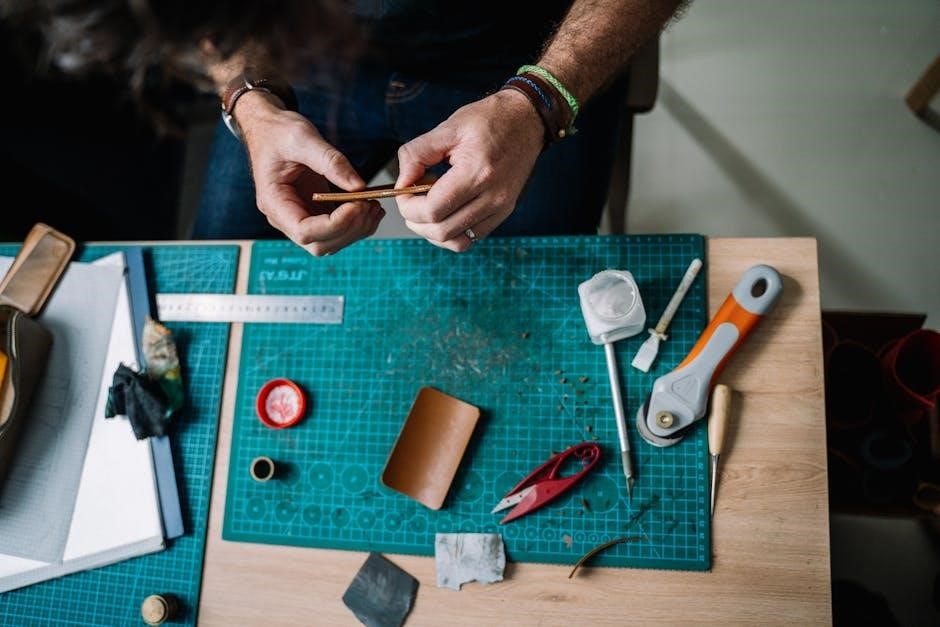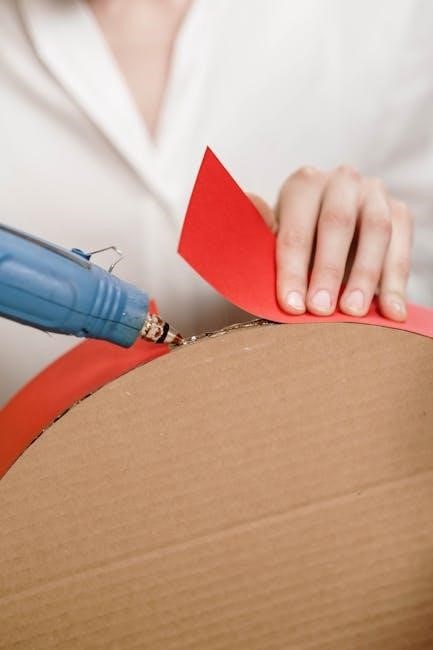
manual transmission sticking
Manual transmission sticking is a common issue where gears become difficult to shift, causing inconvenience and potential damage. Addressing it promptly prevents costly repairs.
1.1 What is Manual Transmission Sticking?
Manual transmission sticking occurs when gears become difficult to shift, causing resistance or hesitation during gear changes. This issue often stems from worn or damaged components like the clutch, gear linkages, or synchros, or from debris accumulation. Sticking can lead to inconvenience, difficulty controlling the vehicle, and potential damage to the transmission if left unaddressed. Prompt attention is essential to prevent further complications.
1.2 Importance of Addressing the Issue

Addressing manual transmission sticking is crucial to prevent further damage and ensure smooth vehicle operation. Ignoring the issue can lead to costly repairs, such as replacing damaged gears or the entire transmission. Additionally, sticking gears can compromise safety by causing unexpected loss of control while driving. Prompt action ensures optimal performance, reduces repair expenses, and maintains driver safety on the road.
Common Causes of Manual Transmission Sticking
Manual transmission sticking often results from worn or damaged components, dirt accumulation, or mechanical issues. Addressing these factors is essential for smooth gear operation and vehicle performance.
2.1 Worn or Damaged Clutch System
A worn or damaged clutch system is a primary cause of manual transmission sticking. When the clutch fails to engage or disengage properly, it hinders smooth gear transitions, leading to difficulty in shifting. Over time, this can cause additional wear on other components, such as the flywheel and pressure plate, exacerbating the issue further. Regular inspection and maintenance are crucial to prevent such problems.
2.2 Sticky or Damaged Gear Linkages
Sticky or damaged gear linkages are another common cause of manual transmission sticking. Dirt, dust, or debris can accumulate in the linkages, causing resistance and difficulty in shifting gears. Over time, physical damage to the linkages can also occur, leading to hesitation or refusal to engage gears properly. If left unaddressed, this can escalate into more severe transmission problems, requiring costly repairs.
2.3 Accumulation of Dirt, Dust, or Debris
Dirt, dust, or debris in the gear linkages or shift mechanism can cause manual transmission sticking. Over time, these contaminants accumulate and create friction, making it harder to shift gears smoothly. Regular cleaning of the gear linkages and shift mechanism is essential to prevent this issue. If left unchecked, it can lead to more severe problems, such as damaged components or complete gear engagement failure.
2.4 Worn or Damaged Gear Teeth
Worn or damaged gear teeth can cause manual transmission sticking by creating uneven surfaces for gears to mesh. This leads to difficulty shifting and grinding sounds. Over time, the gears’ small and large teeth wear down, causing poor engagement. If left unrepaired, this can result in complete gear failure. Regular inspection and timely replacement of worn gears are crucial to maintain smooth transmission operation and prevent further damage.

Symptoms of a Sticking Manual Transmission
Difficulty shifting gears, grinding sounds, and a stiff or unresponsive gear stick are common signs of a sticking manual transmission. Addressing these issues promptly is essential.
3.1 Difficulty Shifting Gears
Difficulty shifting gears is a primary symptom of a sticking manual transmission. Drivers may struggle to move the gear stick, especially when transitioning between gears like first or second. This can feel like the gears are “catching” or refusing to engage smoothly, often requiring extra force or repeated attempts. Such issues can arise from worn or damaged components within the transmission system.
If left unaddressed, this problem can lead to further mechanical damage, emphasizing the importance of early intervention. Consulting a professional mechanic is advisable to diagnose and resolve the root cause effectively, ensuring optimal transmission performance and preventing more severe complications down the line.
3.2 Grinding Sounds During Shifting
Grinding sounds during shifting are another common symptom of a sticking manual transmission. These noises often indicate worn or damaged components, such as gear teeth or synchronizers. The sound typically occurs when the gears struggle to engage smoothly, creating friction and audible grinding.
If grinding persists, it may signal the need for immediate attention to prevent further damage. Checking the clutch system, gear linkages, and lubrication levels can help identify the root cause. Addressing this issue promptly ensures smoother shifting and extends the transmission’s lifespan.
3.3 Stiff or Unresponsive Gear Stick
A stiff or unresponsive gear stick is a noticeable symptom of a sticking manual transmission. This occurs when the gear stick becomes difficult to move, making it hard to engage gears smoothly. Dirt, dust, or debris accumulation in the shift mechanism can cause this issue, as can damaged or worn-out gear linkages. If left unaddressed, it can lead to more severe transmission problems.
Regular cleaning and lubrication of the gear linkage and shift mechanism can often resolve this issue. However, if the problem persists, it may indicate a need for professional inspection or repairs to ensure proper transmission functionality and prevent further damage.

DIY Solutions for Manual Transmission Sticking
DIY solutions include cleaning the gear linkage, replacing worn parts, and adjusting the clutch pedal. These fixes can often resolve sticking issues before professional intervention is needed.
4.1 Cleaning the Gear Linkage and Shift Mechanism
Cleaning the gear linkage and shift mechanism can resolve sticking issues. Use a solvent to remove dirt and debris, then dry and lubricate the components. This ensures smooth operation and prevents further wear. Regular cleaning is a simple yet effective DIY solution to maintain your manual transmission’s performance and reliability over time.
4.2 Replacing Worn or Damaged Parts
Replacing worn or damaged parts is essential for resolving persistent manual transmission sticking. Inspect and replace components like the clutch system, gear linkages, and sync rings. Damaged parts can cause gears to stick or grind, leading to further damage. Always use high-quality replacements and follow proper installation procedures to ensure smooth shifting and optimal performance. Regular inspections can help identify issues before they escalate.
4.3 Adjusting the Clutch Pedal
Adjusting the clutch pedal is a crucial step in resolving manual transmission sticking issues. Proper alignment and tension ensure smooth engagement between the clutch and gearbox. If the pedal is too loose or tight, it can cause difficulty in shifting gears. Use the manufacturer’s specifications to adjust the clutch cable or pedal free play. This simple fix often resolves sticking problems without requiring extensive repairs or replacements.

Maintenance Tips to Prevent Sticking
Regular cleaning and lubrication of the gear linkage and clutch system are essential. Inspecting these components regularly prevents wear and tear, ensuring smooth shifting and optimal performance.
5.1 Regular Cleaning and Lubrication
Regular cleaning of the gear linkage and shift mechanism removes dirt and debris that can cause sticking. Lubricating moving parts ensures smooth operation and prevents wear. Using grease or silicone-based sprays on pivot points and linkages is effective. Clean the clutch pedal and linkage regularly to maintain responsiveness and prevent sticking issues. Consistent maintenance extends the life of your manual transmission.
5.2 Inspecting Gear Linkages and Clutch System
Regularly inspecting gear linkages and the clutch system is crucial to prevent sticking issues. Check for wear, damage, or misalignment in the linkages, as these can disrupt smooth shifting. Inspect the clutch pedal, linkage, and cable for signs of wear or damage. Ensure all components are properly lubricated and functioning correctly. Addressing issues early can prevent major problems and extend the life of your manual transmission.
5.3 Monitoring Shifting Performance
Monitoring shifting performance helps identify issues early, preventing severe problems. Pay attention to smooth gear transitions during acceleration and deceleration. Listen for unusual noises, such as grinding or clunking sounds, which may indicate worn components. Ensure the clutch engages fully and disengages smoothly. Regular checks can help maintain optimal performance and prevent sticking issues from developing into major repairs.

When to Consult a Professional Mechanic
Consult a professional if sticking persists despite DIY efforts or if complex repairs are needed. Seek expert help for severe damage or issues beyond basic maintenance capabilities.
6.1 Severe or Persistent Sticking Issues
If manual transmission sticking issues are severe or persistent, consult a professional. DIY solutions like cleaning or adjusting may not resolve deep mechanical problems. A mechanic can diagnose underlying issues like worn gears or damaged linkages, ensuring proper repairs to restore smooth shifting and prevent further damage to the transmission system.
6.2 Complex Repairs Beyond DIY Capabilities
Some manual transmission issues require specialized tools and expertise. If the problem involves internal components like damaged gear teeth or syncro rings, professional intervention is essential. Complex repairs, such as replacing internal gears or rebuilding the transmission, are best handled by a qualified mechanic to ensure reliability and prevent further damage.
Addressing manual transmission sticking is crucial for optimal performance. Regular maintenance and timely repairs ensure smooth operation and extend the lifespan of your vehicle’s transmission system.
7.1 Summary of Key Points
Manual transmission sticking arises from worn or damaged components like the clutch system, gear linkages, or accumulation of debris. Symptoms include difficulty shifting, grinding sounds, and a stiff gear stick. DIY solutions involve cleaning the shift mechanism, replacing worn parts, and adjusting the clutch. Regular maintenance, such as lubrication and inspections, prevents issues. Persistent problems may require professional intervention to avoid further damage and ensure optimal performance.
7.2 Final Thoughts on Manual Transmission Maintenance
Proper maintenance is key to extending the life of a manual transmission. Regular cleaning, lubrication, and inspections prevent sticking issues. Addressing symptoms early avoids costly repairs. By staying proactive, drivers can ensure smooth shifting and optimal performance. Consistent care not only preserves the transmission but also enhances the overall driving experience, making manual transmissions a reliable and enjoyable choice for years to come.